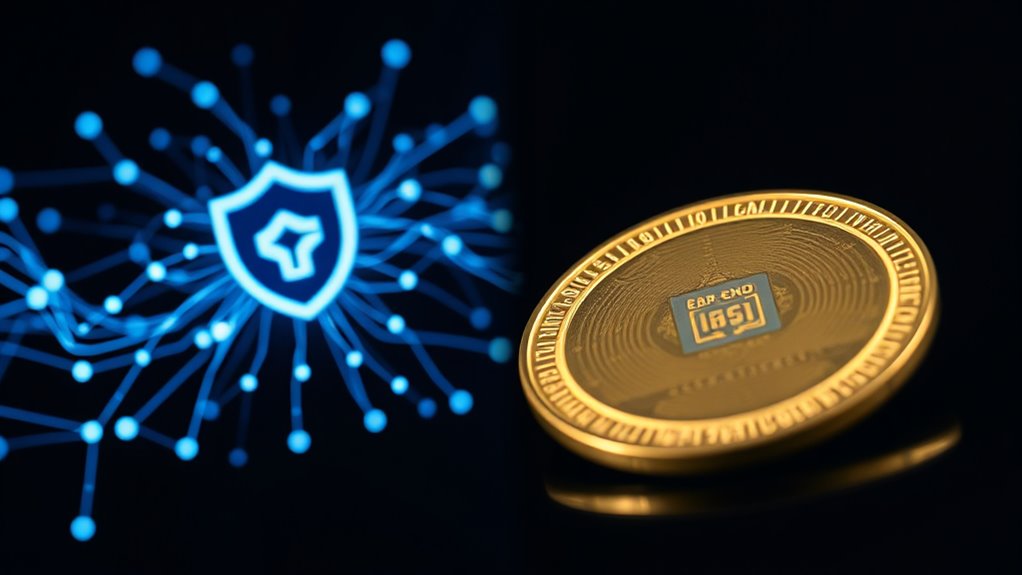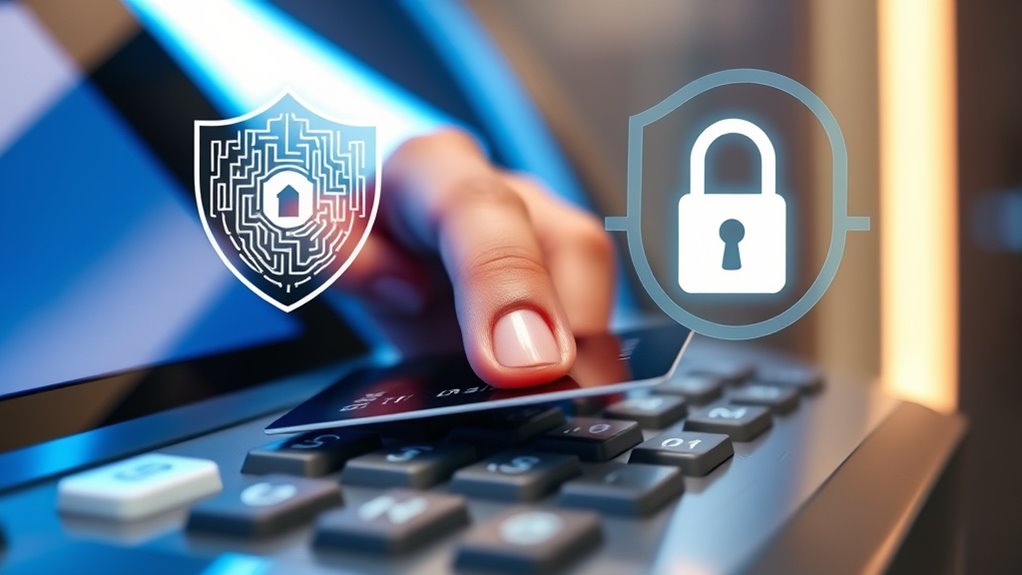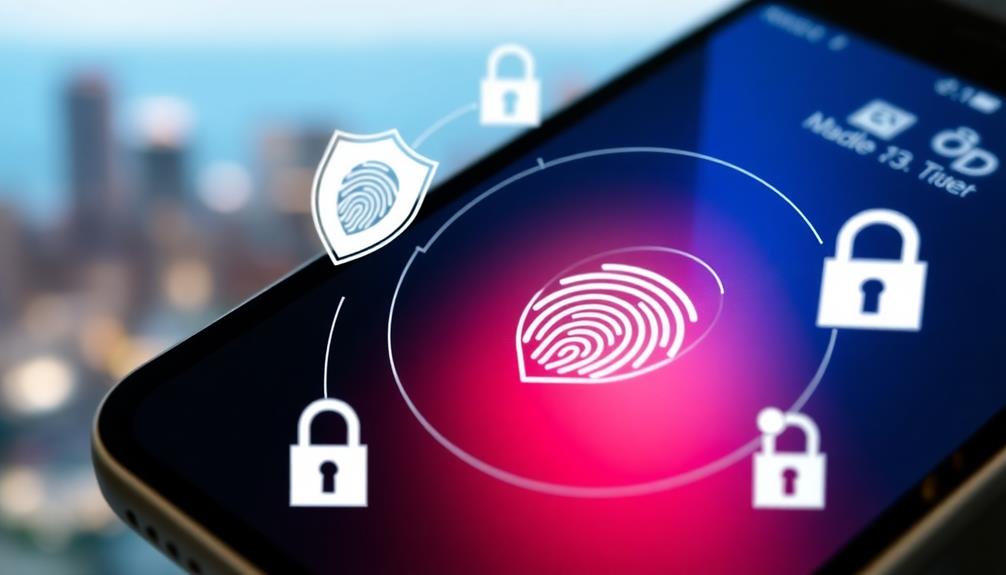End-to-end encryption (E2EE) and tokenization both protect your card data, but they do so differently. E2EE secures your data during transmission, making it unreadable to interceptors, while tokenization replaces sensitive info with non-sensitive tokens, reducing storage risks. Combining both provides layered protection—E2EE for transit and tokenization for storage. To understand which approach best fits your needs, explore how each method strengthens your security approach in different scenarios.
Key Takeaways
- End-to-end encryption protects data during transmission, preventing interception and unauthorized access in transit.
- Tokenization minimizes stored sensitive data, reducing the risk and scope of data breaches at rest.
- E2EE encrypts data end-to-end but does not reduce stored data sensitivity, while tokenization replaces data with non-sensitive tokens.
- Combining both methods offers comprehensive protection: encrypt during transit and tokenize for storage security.
- The best approach depends on whether the focus is securing data in transit (E2EE) or minimizing stored data (tokenization).

When it comes to protecting sensitive data, understanding the differences between end-to-end encryption and tokenization is essential. Both methods are vital tools in your security arsenal, especially when dealing with card data, but they function quite differently. In the domain of cloud security, choosing the right approach can make a significant impact on your compliance standards and overall data integrity. End-to-end encryption (E2EE) ensures that data remains encrypted from the moment it leaves your device until it reaches its final destination. During transmission, the data is unreadable to anyone who intercepts it—be it hackers, malicious insiders, or even cloud service providers—because only the intended recipient holds the decryption key. This method is particularly effective in safeguarding data during transit, making it a preferred choice for securing cardholder information in payment systems. By encrypting data throughout its journey, you minimize the risk of interception and unauthorized access, aligning well with strict compliance standards like PCI DSS, which emphasize data protection during transmission.
Tokenization, on the other hand, replaces sensitive card data with a non-sensitive equivalent called a token. This token has no meaningful value outside your specific system, so even if a breach occurs, the exposed data isn’t useful to attackers. Tokenization shines in cloud security environments because it limits the scope of sensitive data stored or processed in the cloud. Instead of transmitting or storing actual card numbers, your systems handle tokens, reducing your PCI scope and simplifying compliance efforts. This approach mitigates risks associated with data breaches and limits exposure, making it easier to meet compliance standards that require strict data handling procedures. While end-to-end encryption protects data in transit, tokenization focuses on minimizing the stored data footprint, reducing the attack surface and ensuring that even if unauthorized access occurs, the data remains useless to potential intruders.
Both methods have their advantages and limitations, but your choice depends on your specific needs. If your primary concern is securing data during transmission, end-to-end encryption offers robust protection aligned with cloud security best practices. Conversely, if reducing your stored sensitive data footprint is a priority for compliance or operational reasons, tokenization provides an effective solution. In many cases, combining both strategies delivers comprehensive protection—encrypting data in transit and replacing sensitive data with tokens when stored or processed. Ultimately, understanding how each approach works and how they complement each other allows you to design a security framework that effectively safeguards card data, maintains compliance, and upholds your organization’s reputation.
Frequently Asked Questions
Can Both Methods Be Combined for Enhanced Security?
You can definitely combine both methods for layered security, which strengthens threat mitigation. Using end-to-end encryption alongside tokenization ensures that card data remains protected throughout its lifecycle. Encryption secures data during transmission, while tokenization replaces sensitive information with non-sensitive tokens. Together, they create a robust defense, making it harder for cybercriminals to access valuable card data and considerably reducing security vulnerabilities.
Which Method Is More Cost-Effective for Small Businesses?
You’re wondering which method saves you the most money, right? Well, tokenization usually wins in cost comparison for small businesses because it’s simpler and cheaper to implement. End-to-end encryption can be a financial nightmare with higher implementation challenges and ongoing maintenance costs. So, if you’re on a tight budget, tokenization is your best bet—it’s straightforward, cost-effective, and keeps your data protected without draining your resources.
How Do Compliance Standards View Each Protection Method?
You should know that regulatory compliance and security standards view both methods positively, but they emphasize different strengths. End-to-end encryption is praised for securing data during transmission, making it a favorite for meeting strict security standards. Tokenization, however, is valued for reducing the scope of PCI DSS compliance by replacing sensitive data with tokens. Ultimately, integrating both can enhance your security posture and help you meet compliance requirements more effectively.
Are There Any Industry-Specific Preferences for Encryption or Tokenization?
Think of industry preferences as different maps guiding protection choices. In the retail sector, tokenization is like a key that locks away sensitive data, making it popular for safeguarding card info. Meanwhile, the healthcare industry favors encryption, like a secure vault, to protect patient records and sensitive data. Both industries choose based on their unique needs, compliance, and risk levels, ensuring data stays safe and private.
What Are the Potential Vulnerabilities Unique to Each Approach?
You should consider that encryption vulnerabilities can include weak algorithms or key management issues, making data susceptible if not properly secured. Tokenization risks involve potential token reuse or breaches at the token vault, which could expose sensitive data. Both approaches have unique vulnerabilities, so understanding these risks helps you choose the right method. Proper implementation and continuous security assessments are essential to minimize these vulnerabilities and protect your card data effectively.
Conclusion
In the end, knowing the strengths and limitations of both end-to-end encryption and tokenization helps you make smarter security choices. While encryption keeps your data locked tight during transmission, tokenization replaces sensitive info with harmless tokens, reducing risks. Don’t put all your eggs in one basket—consider using both methods together for layered protection. Staying vigilant now can save you from a world of trouble later; it’s better to be safe than sorry.










